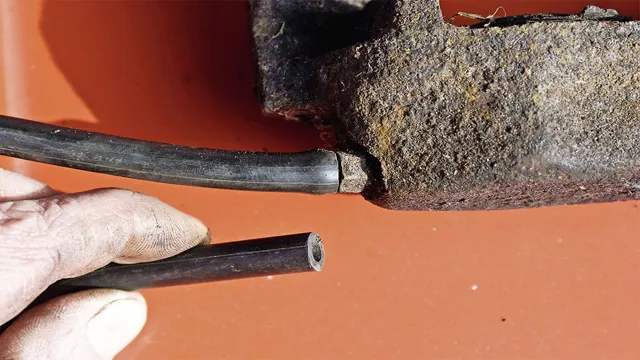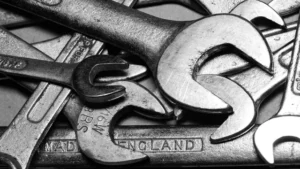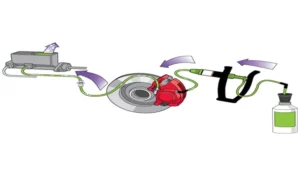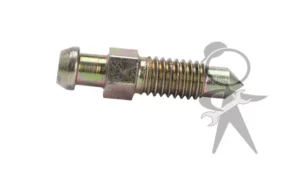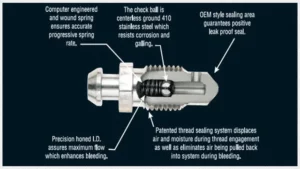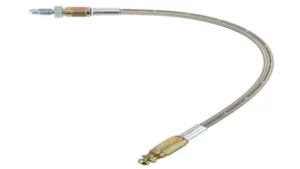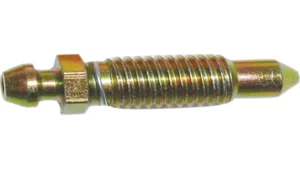Have you ever found yourself in a situation where you’re trying to remove a stripped brake bleeder, only to realize you have no idea what you’re doing? It can be frustrating, time-consuming, and even dangerous. But fear not, as we have the ultimate guide to help you through this daunting task. Removing a stripped brake bleeder requires patience, attention to detail, and the right tools.
First, you need to identify the type of bleeder you’re dealing with and determine if any of the surrounding parts need to be removed. Once you’ve done that, you’ll want to use a combination of heat, penetrating oil, and a specialized tool to try and break the bleeder loose. It’s important to be cautious when attempting to remove a stripped brake bleeder, as overtightening or damaging the surrounding parts can lead to costly repairs down the line.
That’s why we recommend seeking out professional help if you’re unsure about any aspect of this process. However, if you’re confident in your abilities and want to give it a try, our guide will walk you through each step of the process. So let’s roll up our sleeves and get to work, because with the right approach and a bit of determination, you’ll have that stubborn bleeder out in no time!
Understanding the Brake Bleeder
If you’ve ever had experience working with brakes, you know how tricky they can be to handle. One common issue is dealing with a stripped brake bleeder. But don’t worry, it’s not the end of the world! Removing a stripped brake bleeder can be done with a few simple steps.
First, try using a penetrating oil to lubricate the threads and loosen any rust or debris. Then, use a wrench to grip onto the bleeder and slowly turn it counterclockwise. If the bleeder still won’t budge, try using a brake bleeder removal tool or a set of vice grips to get a better grip.
Remember to never force the bleeder out, as this can cause damage to the brake system. Regular maintenance and inspections can also help prevent stripped brake bleeder incidents in the future. By taking care of your brakes, you can both ensure your safety and promote the longevity of your vehicle.
Types and Importance of Brake Bleeders
Brake Bleeder If you own a vehicle, then you know how important it is to keep your brakes in top condition. Brake bleeders play a crucial role in this process by removing air from the brake lines, ensuring that the brakes are working correctly. There are two main types of brake bleeders- manual and automated.
Manual bleeders require a bit of effort to operate, while automated bleeders are more convenient and efficient. Both types are essential in maintaining the proper function of your brakes. Brake bleeders are vital tools for any car owner or mechanic, so if you notice any signs of brake trouble, it’s essential to have them checked out immediately.
Don’t compromise on your safety by neglecting your brakes; with the help of brake bleeders, you can keep your vehicle running smoothly and safely.
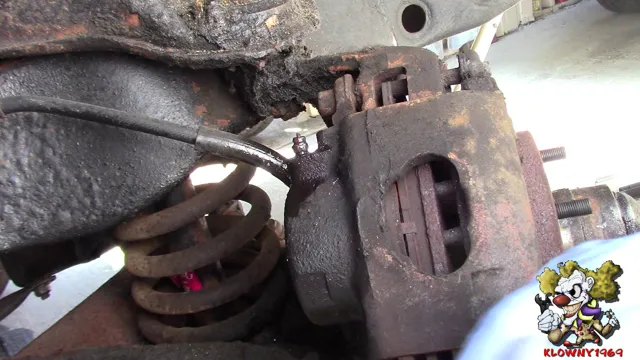
Why a Stripped Brake Bleeder is a Problem
A brake bleeder is a crucial component in the brake system of a vehicle, responsible for removing air and replacing it with fresh brake fluid. However, a stripped brake bleeder can cause serious problems. When the bleeder valve is stripped, it cannot be tightened properly which can lead to air getting back inside the brake system.
Air pockets in the brake system cause spongy brakes, reduced braking power, and may even lead to brake failure. It is important to ensure that brake bleeders are in good condition and properly tightened during any brake system maintenance or repair. So, if you notice any issues with your brake system, it may be a good idea to check the brake bleeder for any signs of damage or stripping.
Don’t neglect the importance of taking care of this small but essential part of your vehicle’s brake system, as it can be the difference between a safe journey and a dangerous accident.
Identifying a Stripped Brake Bleeder
Removing a stripped brake bleeder can be a frustrating task, but with the right tools and techniques, it is possible to get the job done. The first step is to identify whether the bleeder is actually stripped or just corroded. If the bleeder looks damaged or rounded at the top, it is likely stripped.
You can also try using a wrench to turn the bleeder – if it doesn’t move, then it is most likely stripped. To remove a stripped brake bleeder, you can try using a specialized tool called a broken screw extractor. These extractors are designed to grip onto the stripped bleeder and turn it out of the caliper.
Another option is to use vice grips or pliers to grip onto the sides of the bleeder and turn it out. However, this method can damage the threads on the caliper, so it should be used as a last resort. Regardless of the method you choose, be sure to use caution and take your time to avoid causing more damage.
Common Signs of a Stripped Brake Bleeder
Identifying a Stripped Brake Bleeder If you’re having trouble bleeding your brakes or if you’ve noticed brake fluid leaking from your brake bleeder, it may be stripped. A stripped brake bleeder can be a frustrating issue, but it’s essential to identify it so that it can be fixed. One common sign of a stripped brake bleeder is a soft or mushy brake pedal.
This is caused by air getting into the brake lines due to the stripped bleeder screw. Another sign is if you notice fluid leaking from the bleeder screw when you’re trying to bleed the brakes. In some cases, you may also notice that the screw won’t tighten fully or that it’s difficult to loosen due to the damage caused by the stripping.
If you notice any of these signs, it’s important to address the issue right away to ensure that your brake system is functioning correctly. A qualified mechanic can replace the stripped brake bleeder with a new one and make sure that the brake lines are properly bled to prevent any further issues.
Tools Needed for Removal
When it comes to removing a stripped brake bleeder, having the right tools on hand is crucial. You’ll need a set of quality extractors, which typically consist of a hardened steel tool with specially designed teeth that grip onto the damaged screw or bolt. These extractors come in different sizes to accommodate various screw and bolt sizes, so it’s important to choose the right one for your specific situation.
You may also need a drill and drill bit if the stripped bleeder requires a more invasive removal process. Identifying a stripped brake bleeder can be tricky, but there are a few signs to look for. If you notice that the brake bleeder feels loose or won’t tighten properly, or if you’re unable to loosen it despite your best efforts, it’s likely that the threads have been damaged.
In this case, it’s important to take action quickly before further damage occurs. With the right tools and a bit of patience, you can successfully remove a stripped brake bleeder and get your vehicle back on the road in no time.
Methods for Removing a Stripped Brake Bleeder
If you’ve ever stripped a brake bleeder, you know it can be a frustrating and intimidating experience. However, there are methods you can use to remove a stripped brake bleeder. One option is to use a bolt extractor tool, which is designed to grip onto the rounded edges of the bleeder and twist it out.
Another option is to use pliers or vice grips to grip onto the bleeder and turn it clockwise and counterclockwise until it comes loose. If these methods don’t work, you may need to drill a small hole into the center of the bleeder and use an easy out tool to remove it. Whatever method you choose, it’s important to have patience and take your time to avoid damaging the surrounding components.
With a little effort and the right tools, you can successfully remove a stripped brake bleeder and get back on the road safely.
Using a Left-Hand Drill Bit
Removing a stripped brake bleeder can be a frustrating experience for any mechanic. One method to tackle this tricky problem is using a left-hand drill bit. This type of drill bit is designed to turn counterclockwise, which allows it to catch onto the stripped bleeder and drill it out in the opposite direction.
Using a left-hand drill bit requires a steady hand and patience, as it can take some time to drill through the bleeder. It’s important to apply consistent pressure and avoid applying too much force, which can break the bit. Overall, using a left-hand drill bit can be an effective solution for removing a stripped brake bleeder, but it’s important to handle the tool with care to avoid causing further damage to the component.
Using a Stripped Screw Extractor
If you’ve encountered a stripped brake bleeder, you know just how frustrating and complicated it can be. When traditional methods fail, a stripped screw extractor may be necessary to remove the stubborn bleeder. This tool works by drilling a small hole into the center of the bleeder and using a reverse-threaded screw to grip and extract it.
It’s essential to use the correct size extractor for your specific bleeder and to follow the instructions carefully to avoid further damage to your vehicle’s braking system. With patience and a steady hand, using a stripped screw extractor can make the frustrating task of removing a stripped brake bleeder much more manageable. Keep in mind that prevention is key when it comes to stripped brake bleeders, ensuring that they are properly maintained and lubricated can prevent their stripping in the first place.
Using Pliers or Vise Grips
When it comes to removing a stripped brake bleeder, pliers or vise grips can come in handy. One method is to use needle-nose pliers to grip onto the head of the bleeder and turn it counterclockwise. If the bleeder is too stubborn, vise grips can be used to latch onto the edges of the bleeder and loosen it.
However, it’s important to be cautious not to apply too much force that could break the bleeder or damage the brake caliper. It may also be helpful to use penetrating oil or heat to loosen the bleeder before attempting to remove it with pliers or vise grips. Overall, these methods can be effective for removing a stripped brake bleeder, but it’s important to handle the situation with care to avoid causing further damage to the brake system.
Preventing Stripped Brake Bleeders in the Future
Dealing with a stripped brake bleed screw can be a frustrating experience for any car owner. Fortunately, there are ways to prevent this problem from happening in the future. One easy solution is to use an anti-seize lubricant when replacing the brake bleeders.
This will ensure that the screw will not seize up and become stuck in place, leading to stripping. Additionally, it is important to use the correct tools when removing the brake bleeder, such as a properly sized wrench or socket. Trying to force the screw loose with the wrong tool can easily strip the threads.
Finally, take care not to overtighten the brake bleeder, as this can also cause stripping. With these simple precautions, you can avoid the headache of dealing with a stripped brake bleeder and ensure smooth operation of your braking system.
Best Practices for Brake Bleeder Removal and Replacement
One of the essential steps in preventing stripped brake bleeders is to use the right tools and techniques during removal and replacement. First off, make sure you’re using a high-quality wrench that fits perfectly on the bleeder valve. Don’t force the wrench or apply too much torque, as this can cause the bleeder’s delicate threads to wear out or even break.
It’s also wise to apply penetrating oil to the bleeder several hours before working on it, as this will help loosen any rust or corrosion. When it’s time to put the bleeder back in place, consider using a thread sealant or Teflon tape to ensure a snug and secure fit. Remember, taking a few extra steps to protect your brake bleeders now can save you lots of time, money, and headaches down the road.
Tips for Proper Tool Use
When it comes to brake bleeders, stripping can be a common issue that many car owners face. Taking the proper measures to prevent stripped bleeders is crucial in keeping your brakes in top working condition. One of the best tips for proper tool use is to ensure that you’re using the right size wrench.
Using the wrong size can result in stripping and damage to the bleeder. Additionally, it’s important to never force the bleeder while trying to loosen it. Instead, apply steady pressure and use a penetrating oil to help loosen it.
Another helpful tip is to always use a torque wrench when tightening the bleeder after bleeding the brakes. This will prevent over-tightening and potential damage to the threads. By following these simple tips, you can help prevent stripped brake bleeders in the future and ensure that your brakes are working safely and efficiently.
Conclusion and Final Thoughts
In the end, removing a stripped brake bleeder is kind of like solving a puzzle – it requires patience, persistence, and a little bit of creativity. Much like figuring out the perfect strategy for a game of chess, sometimes it takes a series of trial and error to get the job done. But with the right tools, techniques, and a can-do attitude, you can say goodbye to that stubborn bleeder bolt and hello to a fully functioning brake system.
It’s all about being resourceful, adaptable, and up for a challenge – something that, let’s face it, every DIY mechanic lives for. So go forth, my fellow gearheads, and conquer those stripped bolts. Your brakes (and your sanity) will thank you!”
FAQs
What causes a brake bleeder to strip?
A brake bleeder can strip due to excessive force or using the wrong wrench size during installation or removal.
How to remove a stripped brake bleeder?
To remove a stripped brake bleeder, you can use a brake bleeder removal tool, heat the area around the bleeder, or try to grip it with pliers.
Can you reuse a stripped brake bleeder?
No, a stripped brake bleeder should not be reused as it may cause brake fluid leaks or a loss of brake pressure.
How to prevent a brake bleeder from stripping?
To prevent a brake bleeder from stripping, make sure to use the right size wrench and apply only the necessary force. You can also use anti-seize lubricant to prevent corrosion.
What are the dangers of a stripped brake bleeder?
A stripped brake bleeder can cause leaks, a loss of brake pressure, and potentially unsafe driving conditions. It can also cause damage to the brake caliper or wheel cylinder.
Should I replace all the brake bleeders if one is stripped?
It is generally recommended to replace all the brake bleeders if one is stripped to ensure the brake system is functioning properly and prevent future issues.
How often should brake bleeders be checked for damage?
Brake bleeders should be checked for damage during routine brake maintenance and whenever new brake components are installed. It is also recommended to check brake bleeders annually.
